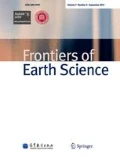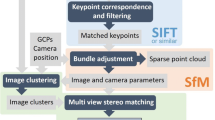Abstract
Global change affected by multiple factors, the consequences of which continue to be far-reaching, has the characteristics of large spatial scale and long-time scale. The demand for Earth observation technology has been increasing for large-scale simultaneous observations and stable global observation over the long-term. A Moon-based observation platform, which uses sensors on the nearside lunar surface, is considered a reasonable solution. However, owing to a lack of appropriate processing methods for optical sensor data, global change study using this platform is not sufficient. This paper proposes two optical sensor imaging processing methods for the Moon-based platform: area imaging processing method (AIPM) and global imaging processing method (GIPM), primarily considering global change characteristics, optical sensor performance, and motion law of the Moon-based platform. First, the study proposes a simulation theory which includes the construction of a Moon-Sun elevation angle model and a global image mosaicking method. Then, coverage images of both image processing methods are simulated, and their features are quantitatively analyzed. Finally, potential applications are discussed. Results show that AIPM, whose coverage is mainly affected by lunar revolution, is approximately between 0% and 50% with a period of 29.5 days, which can help the study of large-scale instant change phenomena. GIPM, whose coverage is affected by Earth revolution, is conducive to the study of long term global-scale phenomena because of its sustained stable observation from 67°N-67°S on the Earth. AIPM and GIPM have great advantages in Earth observation of tripolar regions. The existence of top of the atmosphere (TOA) albedo balance line is verified from the GIPM perspective. These two imaging methods play a significant role in linking observations acquired from the Moon-based platform to Earth large-scale geoscience phenomena, and thus lay a foundation for using this platform to capture global environmental changes and new discoveries.
Similar content being viewed by others
References
Butler D (2014). Earth observation enters next phase. Nature, 508(7495): 160–161
Carruthers G R, Page T (1972). Apollo 16 far-ultraviolet camera/spectrograph: earth observations. Science, 177(4051): 788–791
Chuvieco E, Li J, Yang X (2010). Advances in earth observation of global change. Springer Netherlands, 35(6): 463–483
Civicioglu P (2012). Transforming geocentric cartesian coordinates to geodetic coordinates by using differential search algorithm. Comput Geosci, 46(3): 229–247
Clarke A E, Roy D (2003). Astronomy Principles and Practice (PDF) (4th ed). Bristol: Institute of Physics Pub. p. 59.
Cui K, Xiang J, Zhang Y (2017). Mission planning optimization of video satellite for ground multi-object staring imaging. Advances in Space Research, 2017, 61(6): 1476–1489
Dewitte S, Nevens S (2016). The total solar irradiance climate data record. Astrophys J, 830(1): 25
Ding Y, Guo H, Liu G (2014). Coverage performance analysis of earth observation from lunar base for global change detection. Journal of Hunan University, 41(10): 96–102 (in Chinese)
Dong H, Zou X (2014). Variations of sea ice in the antarctic and arctic from 1997–2006. Front Earth Sci, 8(3): 385–392
Folkner W M, Williams J G, Boggs D H, Park R S, Kuchynka P (2014). The planetary and lunar ephemerides de430 and de431. IPN Progress Report, 196: 1–81
Gao D Y (2012). Global warming and ecology environment change in the three poles of Earth. Chinese Journal of Nature, 34(1): 18–23 (in Chinese)
Guo H, Fu W, Li X, Cen P, Liu G, Li Z, Wang C, Dong Q, Lei L, Bai L, Liu Q (2014). Research on global change scientific satellites. Sci China Earth Sci, 57(2): 204–215 (in Chinese)
Guo H D (2009). Space-based observation for sensitive factors of global change. Bulletin of the Chinese Academy of Sciences, 23(4): 226–228 (in Chinese)
Guo H D, Ding Y X, Liu G, Zhang D W, Fu W X, Zhang L (2014). Conceptual study of lunar-based SAR for global change monitoring. Sci China Earth Sci, 57(8): 1771–1779
Guo H D, Liu G, Ding Y X (2018). Moon-based earth observation: scientific concept and potential applications. Int J Digit Earth, 11(6): 546–557
Guo H D, Zhu LW (2013). Earth observation for global change sensitive variables: mechanisms and methodologie. Bulletin of the Chinese Academy of Sciences, (4): 525–530
Hansen J, Sato M, Kharecha P, von Schuckmann K (2011). Earth energy imbalance and implications. Atmos Chem Phys, 11(9): 27031–27105
Huang S (2008). Surface temperatures at the nearside of the Moon as a record of the radiation budget of Earth climate system. Adv Space Res, 41(11): 1853–1860
Jueterbock A, Smolina I, Coyer J A, Hoarau G (2016). The fate of the arctic seaweed fucus distichus under climate change: an ecological niche modeling approach. Ecol Evol, 6(6): 1712–1724
Karalidi T, Stam D M, Snik F, Bagnulo S, Sparks W B, Keller C U (2012). Observing the earth as an exoplanet with loupe, the lunar observatory for unresolved polarimetry of earth. Planet Space Sci, 74(1): 202–207
Ligas M, Banasik P (2011). Conversion between cartesian and geodetic coordinates on a rotational ellipsoid by solving a system of nonlinear equations. Geodesy and Cartography, 60(2): 145–159
Liu G, Guo H D, Wang X Y, Zhang L (2016). Report on the Scheme and Key Technologies of Lunar Base Earth Observation. Strategic Pioneer Program on Space Science of Chinese Academy of Science
Loeb N G, Wielicki B A, Rose F G, Doelling D R (2007). Variability in global top-of-atmosphere shortwave radiation between 2000 and 2005. Geophys Res Lett, 34(3): L03704
Mouroulis P, Green R O, Chrien T G (2000). Design of pushbroom imaging spectrometers for optimum recovery of spectroscopic and spatial information. Appl Opt, 39(13): 2210–2220
Nie C W, Liao J J, Shen G Z, Duan W T (2018). Simulation of the land surface temperature from moon-based earth observations. Adv Space Res, doi: https://doi.org/10.1016/j.asr.2018.09.041
Pallé E, Goode P R (2009). The lunar terrestrial observatory: observing the earth using photometers on the Moon’s surface. Adv Space Res, 43(7): 1083–1089
Petit G, Luzum B (2010). IERS conventions (2010). IERS Technical Notes, 36: 1–95
Ren Y Z, Guo H D, Liu G, Ye H L (2017). Simulation study of geometric characteristics and coverage for Moon-based Earth observation in the electro-optical region. IEEE J Sel Top Appl Earth Obs Remote Sens, 10(6): 2431–2440
Schombert J (2011). Earth Coordinate System. University of Oregon Department of Physics.
Smith W K, Gao W, Steltzer H (2009). Current and future impacts of ultraviolet radiation on the terrestrial carbon balance. Front Earth Sci China, 3(1): 34–41
Stephens G L, O’Brien D, Webster P J, Pilewski P, Kato S, Li J (2015). The albedo of Earth. Rev Geophys, 53(1): 141–163
Tsukamoto A, Kamisaka W, Senda H, Niisoe N, Aoki H, Otagaki T (1996). High sensitivity pixel technology for a 1/4-inch PAL 430 k pixel IT-CCD. In: Proceedings of IEEE Custom Integrated Circuits Conference
Voigt A, Stevens B, Bader J, Mauritsen T (2013). The observed hemispheric symmetry in reflected shortwave irradiance. J Clim, 26(2): 468–477
Wild M (2009). Global environmental change. J Geophys Res D Atmospheres, 114(11): D00D16
Wu J (1999). Hierarchy and scaling: extrapolating information along a scaling ladder. Can J Rem Sens, 25(4): 367–380
Xu Z, Chen K S (2018). On signal modeling of Moon-based synthetic aperture radar (SAR) imaging of earth. Remote Sens, 10(3): 486
Ye H L, Guo H D, Liu G, Ren Y Z (2017). Observation scope and spatial coverage analysis for earth observation from a Moon-based platform. Int J Remote Sens: 1–25
Ye H L, Guo H D, Liu G, Ren Y Z (2018). Observation duration analysis for Earth surface features from a Moon-based platform. Adv Space Res, 62(2): 274–287
Zhang D W (2012). Study on methodology of lunar-based Earth observation for global change. Dissertation for the Master Degree. Shanghai: East China Normal University (in Chinese)
Zhu C, Xie Zh, Li F (2012). An Introduction to Global Change Science (3rd ed). Beijing: Science Press (in Chinese)
Acknowledgements
This research was supported by the National Natural Science Foundation of China (Grant No. 41590853) and the Key Research Program of Frontier Sciences of Chinese Academy of Sciences (Grant No. QYZDY-SSW-DQC026). We also thanks NASA Jet Propulsion Laboratory for providing the free ephemeris data.
Author information
Authors and Affiliations
Corresponding author
Rights and permissions
About this article
Cite this article
Li, T., Guo, H., Zhang, L. et al. Simulation of Moon-based Earth observation optical image processing methods for global change study. Front. Earth Sci. 14, 236–250 (2020). https://doi.org/10.1007/s11707-019-0749-9
Received:
Accepted:
Published:
Issue Date:
DOI: https://doi.org/10.1007/s11707-019-0749-9




